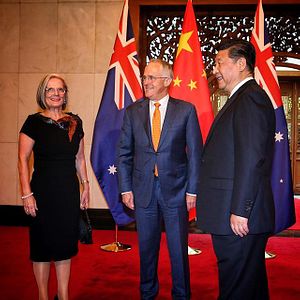China may be Australia’s largest trading partner by far, and an increasingly important source of investment. But Canberra remains conflicted in how to respond to the Belt and Road Initiative (BRI).
After turning down Chinese overtures to sign a Memorandum of Understanding (MOU) on BRI cooperation when Chinese Premier Li Keqiang visited in March, Trade Minister Steven Ciobo announced in September that an MOU has now been signed. But that came with the proviso that cooperation was limited to investment and infrastructure in third countries, which may include BRI projects.
In contrast, Australia’s neighbor, New Zealand, signed a wide-ranging MOU earlier this year and is now in the middle of an 18-month project to formulate a detailed work plan.
Australian hesitation seems to stem from four areas.
The first is a concern the BRI will lead to a strategic outcome unfavorable to Australia’s security ally, the United States. But the big strategic shifts in the Asia-Pacific are connected to China’s economic rise. China now spends more on its military than the rest of Asia combined. Yet this still only amounts to 1.9 percent of its GDP, lower than in Australia (2.0 percent), and much lower than in the United States (3.3 percent). Short of Washington and its allies, partners, and friends adopting an active China containment strategy, this trend is likely to continue, irrespective of the BRI, although the BRI might accelerate it.
A second concern is that the lack of a detailed pipeline of potential projects makes practical participation difficult. One issue with this is that the BRI at its inception was not intended as a blueprint, but rather a general proposition to cooperate on addressing the problem of poor connectivity. The fact that the BRI may also align with China’s geostrategic preferences doesn’t necessarily undercut its economic logic.
China has suggested cooperation could range across infrastructure provision, policy coordination, trade and finance facilitation, and accelerating people-to-people links. The BRI’s flexibility could provide opportunities for creative Australian diplomacy.
For example, the political capital that China is staking on the BRI could be tapped in a bid to update the three-decade old bilateral investment treaty (BIT) between the two countries. The China-Australia Free Trade Agreement (ChAFTA) struck in 2015 features a commitment to review the BIT within three years, including the possibility of moving to a negative list approach. But the BRI is now far more central to China’s foreign policy agenda than ChAFTA. Bringing these negotiations under the banner of both ChAFTA and the BRI would provide a powerful impetus for the review to produce tangible outcomes.
A third consideration revolves around the transparency and governance of future BRI projects. Last month Frances Adamson, secretary of the Australian Department of Foreign Affairs and Trade, specifically cited the debt that Pacific Island countries had racked up after embarking on infrastructure projects that had come with “very heavy price tags.” For example, two-thirds of Tonga’s external debt is now owed to China, equating to around 25 percent of its GDP.
But as the BRI’s main sponsor, China is not without financial and reputational incentives to take steps that promote the BRI’s effectiveness and long-term likelihood of success. The same considerations were in play when China proposed setting up the Asia Infrastructure Investment Bank (AIIB) in 2013. At the time U.S. President Barack Obama warned Australia off participating in the bank because of transparency and governance issues. Yet the AIIB is now widely regarded as a multilateral institution with world-class operating practices. Of course, the AIIB and the BRI are two different beasts, but the AIIB still serves as a reminder of the possibilities that engagement offers.
Considering that the BRI will go ahead with or without Australia, the money that China is willing to commit to the BRI could be used to leverage Australian funds and project evaluation expertise to boost for regional aid and development.
Australia and China already operate a flagship bilateral aid cooperation project focused on alleviating malaria in Papua New Guinea. Such cooperation could potentially be scaled up through the BRI.
All Chinese investment in Australia will still need to go through the same foreign investment approvals regime, BRI-badged or not, with the Commonwealth Treasurer retaining the right to reject bids they deem not to be in the national interest.
The BRI also wouldn’t bind Australia to China to the exclusion of an open, competitive bidding process. It may, however, act to increase Chinese interest and the value of Australian assets, and in some cases, Chinese companies may emerge as the only bidders.
A final reason sometimes cited is that signing up to the BRI won’t deliver any additional benefits. This is often stated in terms of Australia already being successful in attracting Chinese investment.
But when trade was already booming earlier this decade, the Australian government still pursued an FTA with China, recognizing that such architecture would best position the country to take advantage of the opportunities as they unfolded.
And some Australian regions do struggle to attract the investment that supports local jobs, as the Australian government’s own AU$5 billion Northern Australia Infrastructure Facility makes plain.
There is also a regional dimension to Australia’s national interest. The Asian Development Bank (ADB) says that emerging economies are in need of infrastructure investment totaling $1.7 trillion a year to maintain growth and alleviate poverty. The ADB itself provides less than one percent of that.
These considerations might help inform the debate about whether greater engagement with the BRI is consistent with Australia’s national interest.
James Laurenceson is Deputy Director of the Australia-China Relations Institute, University of Technology Sydney. Simone van Nieuwenhuizen is Project and Research Officer at the Australia-China Relations Institute. Elena Collinson is Senior Project and Research Officer at the Australia-China Relations Institute.

































